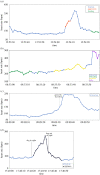Heart rate as a measure of emotional arousal in evolutionary biology
- PMID: 34176323
- PMCID: PMC8237168
- DOI: 10.1098/rstb.2020.0479
Heart rate as a measure of emotional arousal in evolutionary biology
Abstract
How individuals interact with their environment and respond to changes is a key area of research in evolutionary biology. A physiological parameter that provides an instant proxy for the activation of the automatic nervous system, and can be measured relatively easily, is modulation of heart rate. Over the past four decades, heart rate has been used to assess emotional arousal in non-human animals in a variety of contexts, including social behaviour, animal cognition, animal welfare and animal personality. In this review, I summarize how measuring heart rate has provided new insights into how social animals cope with challenges in their environment. I assess the advantages and limitations of different technologies used to measure heart rate in this context, including wearable heart rate belts and implantable transmitters, and provide an overview of prospective research avenues using established and new technologies, with a special focus on implications for applied research on animal welfare. This article is part of the theme issue 'Measuring physiology in free-living animals (Part II)'.
Keywords: animal welfare; cognition; emotional arousal; heart rate; individual differences; social behaviour.
Figures

References
-
- Seyle H. 1976. The stress of life. New York, NY: McGraw-Hill.
-
- von Holst D. 1998. The concept of stress and its relevance for animal behavior. In Advances in the study of behavior 27, 1-131. New York, NY: Academic Press. (10.1016/S0065-3454(08)60362-9) - DOI
Publication types
MeSH terms
LinkOut - more resources
Full Text Sources
Miscellaneous

